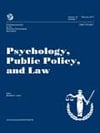
Negligence judgments by judges were biased by hindsight. This is the bottom line of a recently published article in Psychology, Public Policy, and Law. Below is a summary of the research and findings as well as a translation of this research into practice.

Featured Article | Psychology, Public Policy, and Law | 2016, Vol. 22, No. 3, 271-279
When Being Wise After the Event Results in Injustice: Evidence for Hindsight Bias in Judges’ Negligence Assessments
Authors
Aileen Oeberst, Leibniz-Institut für Wissensmedien
Ingke Goeckenjan, Ruhr-Universität Bochum
Abstract
Research on hindsight bias has demonstrated that people perceive and evaluate events differently once they know about their outcome. One facet of hindsight bias is that people often perceive past events as more foreseeable than they do without outcome knowledge. This finding is of great importance in the legal context. Specifically, negligence judgments are based on the decision-makers’ evaluation of how foreseeable the harm that occurred was. Crucially, legal decision-making always takes place after some harm has already occurred (i.e., in hindsight). Whereas numerous studies already document a hindsight bias in laypeoples’ negligence judgments, the evidence for professional judges is sparse and inconsistent. We conducted an experiment with judges and found negligence judgments in a criminal law case to be also biased by hindsight. Judges with outcome knowledge perceived the occurred harm as significantly more foreseeable, which in turn led to a more frequent affirmation of negligence. We discuss these findings with a focus on implications and potential countermeasures.
Keywords
hindsight bias, foreseeability, negligence, criminal judgments, legal decision-making
Summary of the Research
Introduction
“A long and prolific research tradition in psychology has established that our perceptions of events change once these events have occurred. In hindsight, people overestimate what they could have known in foresight. Specifically, hindsight bias comprises of three different components: increased perceptions of inevitability (e.g., “It must have happened”); increased perceptions of foreseeability (e.g., “I knew it would happen”); and memory distortions (e.g., “I predicted that it would happen”)” (p. 271).
“Why does hindsight bias occur? It is a consensus that several factors play a role. One factor that has been repeatedly empirically supported is causal reasoning: People are generally motivated to understand why things happen in the world. When they search for an explanation for an event that occurred, however, they focus mainly on antecedents, which are consistent with the event (i.e., argued for the occurrence of the event), because they seem to explain the event. Antecedents that are inconsistent with the event, in contrast, are largely ignored or assigned little weight” (p. 272).
“Similar to historians, judicial decision-makers are dealing with past events: Trials typically take place after some harm or damage has occurred. For one type of judgment it is particularly plausible to assume that hindsight bias to plays a role, that is, negligence . . . In many legal systems there are at least two necessary preconditions for criminal negligence. First, negligence is assumed if the harm was caused by a breach of duty of care. Second, it is additionally required to establish that it was foreseeable that the negligent act would imperil others . . . Thus, the court has to determine—post hoc—whether the defendant could have foreseen the harm resulting from his or her careless behavior. As mentioned above, however, foreseeability is one of the components that may change with hindsight: after an event, people tend to perceive it as having been more foreseeable than before that event took place” (p. 272).
“To date, quite a few studies have investigated hindsight bias in the legal context. With regard to negligence judgments, the overwhelming majority of studies have demonstrated an effect of hindsight: Negligence was significantly more often affirmed if participants knew that some harm had occurred versus not. This finding, however, is only clear-cut when students or jury-eligible people were examined, which was the case for almost all studies. By contrast, the evidence for judges is sparse and mixed” (p. 273).
“The present empirical evidence allows for no conclusions as to whether assessments made by professional judges are likely biased by hindsight or whether they are mostly able to disregard outcome knowledge when it comes to negligence. The present study was therefore designed to fill this gap by investigating the impact of outcome knowledge in negligence judgments of judges. Extending prior research, we also aimed at examining the link between foreseeability and negligence more directly. Specifically, we analyzed whether perceived foreseeability mediated effects of outcome knowledge on negligence judgments. Finally, we also assessed breach of duty of care (BDC), given that it is the second defining element of negligence. This allows us to examine, whether both foreseeability and BDC predict negligence judgments” (p. 273).
Method
“In order to assess whether judges’ negligence judgments were affected by hindsight we presented a case (for more details on case see article) to professional decisionmakers either with or without the outcome and asked them for their perceived foreseeability of the outcome as well as for negligence judgments . . . Altogether, 84 German judges took part in the experiment. Recruitment took place during training courses for judges. On average they were 31.31-years-old and had 1 to 8 years of professional trial-related experience. They were randomly assigned to one of the two conditions” (p. 274).
Results
When we asked professional judges, we found an effect of outcome knowledge on perceptions of foreseeability regarding that outcome. More importantly, since negligence judgments comprise foreseeability perceptions, the effect of outcome knowledge on foreseeability evaluations resulted in biased negligence judgments . . . This effect of outcome knowledge on negligence judgments was mediated by the perceived foreseeability of the harm. In other words, judges succumbed to the classic hindsight bias and this bias translated into biased negligence judgments” (p. 276).
“Those with the benefit of hindsight believed that they would have foreseen the harm to a much greater extent than judges with genuine foresight actually did. Due to these heightened foreseeability impressions judges in the hindsight condition were more likely to affirm negligence judgments. Obviously, they also expected that the defendant should have foreseen the occurrence of the harm to the extent they did—with the benefit of hindsight. Consequently, judges were not able to correct for hindsight bias and thus were unable to sufficiently take the ex ante perspective into account when arriving at their judgment as they were supposed to” (p. 276).
“A note regarding the foreseeability perceptions of a general harm is necessary as we did not find any significant differences between the foresight and hindsight condition with this measure. Our reasoning for including the item was twofold: First, the very specific and detailed descriptions of the outcomes (actual and alternatives) might evoke a feeling that one would have never foreseen any of them—in detail. Therefore, we aimed at tapping the rather general perception that a harmful outcome was foreseeable. Second, the description of different events may indirectly foster the consideration of alternative outcomes, which might lead to an underestimation of the actual effect. Therefore, we asked generally before presenting alternatives. In fact, however, we found a hindsight bias when comparing the perceived foreseeability of the actual outcome, but not when comparing the perceived foreseeability of a general harm. The null-effect might be due to the lacking specification, which might have led to different meanings in the foresight and the hindsight condition as the latter would think of the actual outcome whereas the former would have to guess” (p. 276).
Translating Research into Practice
“Our findings clearly show that bias is not automatically prevented if legal decisions are made by professional judges. Obviously, their professional education does not prevent unfair judgments. This raises the question, why not?” (p. 276).
“Several outlooks argue for the pervasiveness of hindsight bias. First, people are rarely aware of it. Second, awareness (knowledge) alone does not prevent it.
Rather, only effortful considerations of how the same antecedents could have led to a different outcome—known as the “consider-the-opposite” technique—have been shown to effectively reduce or even eliminate hindsight bias. Crucially, the fact that people need to be instructed to consider alternative outcomes in order to show less or no hindsight bias indicates that they do not spontaneously do so. Third, hindsight bias is not an error of intuition or the application of simple heuristics. Rather, hindsight bias results from elaborate and effortful causal reasoning. It is precisely when people do not have enough cognitive resources available for sense-making and causal reasoning that hindsight bias does not occur. Hence, hindsight bias is not an intuitive error that vanishes with deliberation. Instead, hindsight bias results from deliberation and can only be reduced or eliminated by specific types of deliberation, namely the consideration of alternative outcomes” (p. 276-277).
“But what, then, could help to avoid hindsight bias in negligence judgments? One of the most effective measures against hindsight bias is the consider-the-opposite (CTO) technique. However, studies with judges and with regard to negligence judgments in criminal law are lacking to date. Moreover, one might question the practicability of this intervention. After all, how could a systematic employment of this technique by judges be ensured? Wouldn’t it be easier to limit the information that is accessible to those, who judge? That is, to eliminate hindsight bias by eliminating the hindsight perspective in general and providing judges with the foresight perspective only when making their decision? For the U.S. jurisdiction this possibility has been discussed extensively under the label of “trial bifurcation” (p. 277).
Other Interesting Tidbits for Researchers and Clinicians
“In Germany “trial bifurcation” seems impossible for at least two reasons: First, for constitutional reasons no one but the competent judge would be legitimized to limit the available information. Second, negligence offenses always require the causation of a harm foreseeable to the defendant. Hence, outcome knowledge is a necessary prerequisite for negligence judgments” (p. 277).
“There might be, however, the possibility to employ this technique, when it comes to expert witness reports. Consider the case of medical malpractice. To avoid hindsight bias, one could provide the expert witness with only the information that was available to the defendant at the time of his or her behavior. It must be acknowledged, however, that such a “blind” expert report would be impossible in cases of high popularity” (p. 277).
Join the Discussion
As always, please join the discussion below if you have thoughts or comments to add!






















